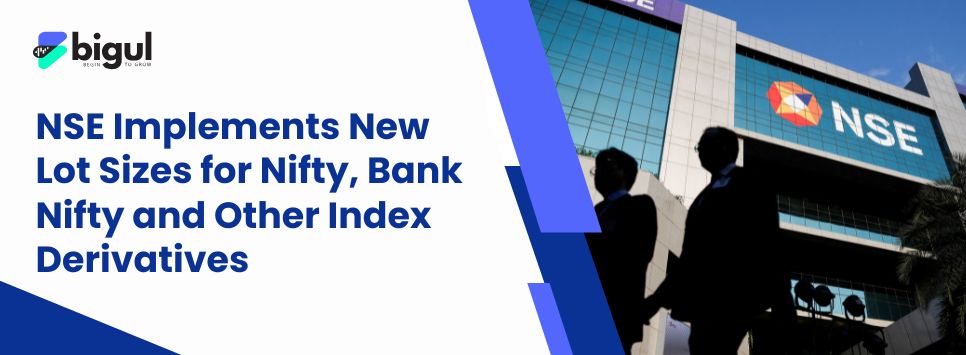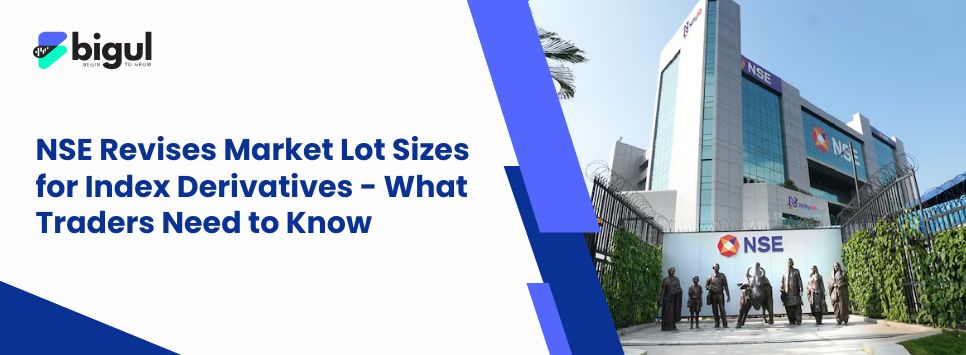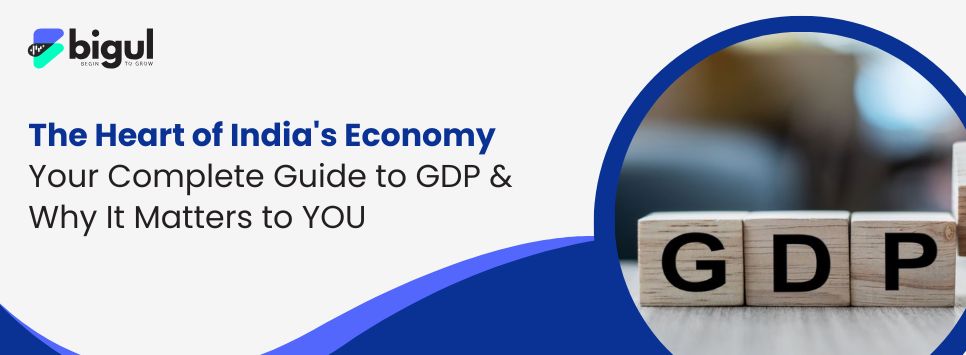Forget dry economic jargon for a moment. Imagine this: You're scrolling through news apps, seeing headlines scream "India's GDP Growth Soars!" or fret "Growth Slows, Job Market Tightens." Your uncle complains about rising prices at the vegetable market. Unbeknownst to them, India's GDP – that three-letter acronym which connects us all It’s the pulse of our nation's economic health, impacting your job prospects, your income, the price of your groceries, and the government's ability to build roads, schools, and hospitals.
So, what is GDP of India, really? How is it measured? And why should you, genuinely care? Let’s dive deep.
Also Read | Nifty ETFs 101: A Complete Guide for Indian Investors
What Exactly is GDP? It's More Than Just a Number
Let’s start with the absolute basics: What is GDP? GDP stands for Gross Domestic Product. Think of it as the ultimate scorecard for a country's economic activity within a specific period – usually a quarter (three months) or a year. It represents the total monetary value of all final goods and services produced within India's geographical borders, regardless of whether the producer is Indian or foreign-owned.
-
Gross: It means total, without subtracting anything (like depreciation of assets) yet.
-
Domestic: It counts economic activity happening physically within India.
-
Product: It focuses on newly produced goods and services. Selling your old bike doesn't count; manufacturing a new one does.
Why is India GDP Such a Big Deal?
Simply put, India GDP growth is seen as the primary indicator of our nation's economic progress. Here’s why it’s constantly in the spotlight:
-
Measure of Economic Size: It tells us how large the Indian economy is compared to others. Are we the 5th largest? Aiming for 3rd? GDP is the measuring tape.
-
Gauge of Economic Health: Rising GDP generally signals a growing economy – businesses are producing more, people are earning and spending more. Falling GDP indicates contraction, often leading to job losses and hardship.
-
Guide for Policy: The government and the Reserve Bank of India (RBI) obsess over GDP data. It shapes decisions on interest rates (to control inflation or boost spending), tax policies, infrastructure investment, and social welfare schemes.
-
Investor Magnet: Strong India GDP growth rate attracts foreign investors. They see potential for profits, bringing in capital that funds new businesses, creates jobs, and upgrades technology.
-
Living Standards Link: Despite problems,a consistent increase in GDP helps raise living standards for the average person year after year. It offers the funds for improving healthcare, schools and public facilities.
Cracking the Code: How to Calculate GDP?
So, how to calculate GDP? Economists use three main approaches, all aiming to arrive at the same total figure. Imagine the entire economy as a giant, complex machine:
-
The Production (or Value-Added) Approach:
-
This method calculates GDP by adding up the value added at each stage of production across all industries within India.
-
Value Added = Value of Output - Value of Intermediate Goods Used.
-
Example: A farmer grows wheat (output value: Rs. 100). He sells it to a miller who turns it into flour. The miller's output is flour worth Rs. 150, but he used Rs. 100 worth of wheat. His value added is Rs. 50. The miller sells flour to a baker who makes bread worth Rs. 250. The baker's value added is Rs. 250 - Rs. 150 = Rs. 100. Total GDP contribution from this chain: Farmer (Rs. 100) + Miller (Rs. 50) + Baker (Rs. 100) = Rs. 250 (the value of the final bread).
-
This approach sums value added from Agriculture, Industry (Manufacturing, Construction, Utilities), and Services (IT, Finance, Trade, Transport, Government, etc.).
-
The Expenditure Approach:
-
This is the most common way GDP is discussed. It calculates GDP by adding up all the spending on final goods and services produced in India. The formula is:
-
GDP = C + I + G + (X - M)
-
C = Private Consumption Expenditure: This is you and me! It's spending by households on everything from food, clothes, rent, and gadgets to doctor's fees and movie tickets. This is usually the largest component.
-
I = Gross Fixed Capital Formation (Investment): This is spending by businesses on machinery, buildings, factories, technology, and also investment in building new homes. It also includes changes in inventories (unsold goods). Investment is crucial for future growth.
-
G = Government Final Consumption Expenditure: This is spending by the central and state governments on salaries, defense, public services, etc. It does NOT include transfer payments like pensions or subsidies, as those are just moving money around, not paying for newly produced goods/services.
-
(X - M) = Net Exports: X is Exports (goods and services produced in India and sold abroad). M is Imports (goods and services produced abroad and bought by Indians). We subtract Imports because they represent spending on foreign production, not Indian.
-
The Income Approach:
-
This method calculates GDP by adding up all the incomes earned by individuals and businesses within India from producing goods and services.
-
It includes:
-
Wages and Salaries (Compensation of Employees)
-
Profits of Companies (Operating Surplus)
-
Rent Income
-
Interest Income
-
Taxes on Production (like excise duty) minus any Subsidies the government provides.
India's GDP And Growth Rate : The Current Landscape and Key Metrics
Now, let's zoom in on India GDP specifically. As of recent estimates (2023-24), India's economy stands strong as the 5th largest in the world, measured by nominal GDP (which uses current market prices). In terms of Purchasing Power Parity (PPP), which adjusts for price differences between countries, we are the 3rd largest.
-
India GDP in Trillion: Going beyond one trillion was a major achievement. India’s GDP today is valued at many trillions. As perspective, GDP nominal in 2023-24 was about $3.7 trillion. Our size plays a big role in our influence around the world.
Meanwhile, the Indian GDP growth rate is arguably the most watched number. It tells us how fast (or slow) the economy is expanding year-on-year or quarter-on-quarter. Think of it as the speedometer of our economic vehicle.
-
Recent Trends: India has been one of the world's fastest-growing major economies for much of the past decade, often clocking growth rates above 7%. While the pandemic caused a sharp contraction, the recovery has been robust. Estimates for India GDP 2024 (FY24) suggest growth around 7.6% or higher. Projections for India GDP 2025 (FY25) hover around 6.5% to 7%, reflecting global headwinds but underlying resilience.
-
India GDP Growth Rate Last 10 Years: This period has been a rollercoaster! We saw strong growth pre-pandemic (peaking near 8.3% in FY17), the sharp pandemic dip (-5.8% in FY21), followed by a strong rebound (9.7% in FY22). The average over this turbulent decade still highlights India's significant growth potential compared to global peers. Understanding this India GDP growth rate last 10 years context is crucial.
Beyond the Aggregate: GDP Per Capita and What It Means for You
While the overall India GDP number is impressive, it doesn't tell the whole story about individual prosperity. This is where India GDP per capita comes in.
-
What is GDP per capita? It's simply the total GDP divided by the country's population. It gives a rough average of the economic value available per person.
-
India GDP per capita: As of 2023-24, India's GDP per capita is estimated around $2,600-$2,700 (nominal). This places us firmly in the lower-middle-income category globally. While our total GDP is massive, our per capita income is still significantly lower than developed nations and even some emerging peers. This highlights the challenge of translating aggregate growth into widespread individual prosperity for our vast population of over 1.4 billion.
-
Why it Matters to YOU: India GDP per capita growth is a better indicator of potential improvements in average living standards than just total GDP growth. If GDP grows slower than the population, per capita income stagnates or falls. Your personal income growth is heavily influenced by the trajectory of per capita GDP.
Nominal vs. Real GDP: Seeing Through the Price Fog
Remember that nominal GDP figure we mentioned? It uses current market prices. But prices change – inflation pushes them up, deflation pulls them down. This can distort the picture of actual physical production growth.
-
What is nominal GDP? GDP measured using current prices in the year the output is produced. If prices rise (inflation), nominal GDP rises even if we produce the exact same amount of stuff.
-
Real GDP: This is the crucial adjustment. Real GDP measures the value of goods and services produced using constant prices from a base year. It strips out the effect of inflation or deflation, showing the actual change in the volume of goods and services produced – the real growth.
-
The Growth Rate Difference: The India GDP growth rate you most often hear quoted (like the 7.6% for FY24) is almost always the Real GDP growth rate. This tells us how much the economy actually expanded after accounting for price changes. A high nominal growth rate with high inflation isn't necessarily good news.
The Balancing Act: Debt to GDP Ratio India
Growth is essential, but how it's financed matters immensely. This brings us to a critical metric for stability: the debt-to-GDP ratio in India.
-
What it Measures: This ratio compares the total government debt (central + state) to the country's GDP. It essentially shows how big the government's debt burden is relative to the size of the entire economy – its capacity to generate income to service that debt.
-
India's Position: India's general government debt (Centre + States) hovers around 80-85% of GDP. This is considered moderately high. While lower than some developed nations (like Japan or the US), it's higher than many emerging market peers and above the often-cited 60-70% "prudent" threshold for developing economies.
-
Why YOU Should Care:
-
Fiscal Space: A high debt to GDP ratio India limits the government's ability to spend on crucial areas like health, education, and infrastructure without borrowing even more or raising taxes significantly.
-
Interest Burden: Because the government spends a lot on debt interest, there is less left over for building the economy or aiding those in need.
-
Economic Stability: Very high debt levels can spook investors, lead to higher borrowing costs for the government and potentially the private sector, and make the economy more vulnerable to external shocks. Managing this ratio is vital for long-term stability.
The Internal Mosaic: Highest GDP State in India
India's growth story isn't uniform. There are significant disparities across states. Identifying the highest GDP state in India reveals economic powerhouses and laggards.
-
The Leaders: Maharashtra consistently tops the list in terms of absolute Gross State Domestic Product (GSDP), driven by its massive financial capital Mumbai, a strong industrial base, and a thriving services sector. Other high-contributing states include Tamil Nadu (manufacturing, auto), Karnataka (IT hub Bangalore), Gujarat (industries, ports), and Uttar Pradesh (large population, growing services).
-
Per Capita Leaders: When looking at GSDP per capita, smaller states like Goa, Sikkim, Telangana, and Haryana often lead, reflecting higher relative prosperity, while larger, more populous states like Bihar and Uttar Pradesh rank lower.
-
The Challenge: Bridging the gap between the highest GDP state in India and the lower-income states is critical for inclusive growth. It needs investments in infrastructure, education, and healthcare.
The Road Ahead: GDP Growth Rate of India 2025 and Beyond
Forecasting is tricky, but understanding the projections for the GDP growth rate of India 2025 helps set expectations.
-
FY25 Projections: The IMF, World Bank and RBI expect India’s real GDP growth for the FY25 (2024-25) to be between 6.5% and 7.0%. Although the figure for FY25 is lower than the year earlier, it places India as a world growth leader.
-
Key Drivers: Continued strength in services (especially IT), a rebound in manufacturing (supported by government initiatives like PLI), resilient domestic consumption, and sustained government capital expenditure on infrastructure are expected to fuel growth.
-
Key Challenges: Global slowdown/recession risks, geopolitical tensions affecting trade and oil prices, uneven monsoon impacting agriculture and rural demand, the need for private investment to pick up pace, and managing inflation remain critical factors influencing the GDP growth rate of India 2025 and beyond.
Why GDP Matters in Your Daily Life (Yes, Really!)
You might still wonder, "Okay, but how does this abstract GDP number affect me directly?" Let's connect the dots:
-
Jobs & Salaries: A strong India GDP growth rate usually means businesses are expanding, leading to more job creation and potentially better salary hikes. A slowdown often brings hiring freezes or layoffs.
-
Business Opportunities: Entrepreneurs find it easier to start and grow businesses in a rapidly expanding economy. Access to funding improves, and consumer demand is stronger.
-
Interest Rates: The RBI sets interest rates partly based on GDP growth and inflation. High growth with high inflation might mean higher loan EMIs (for homes, cars, education). Slower growth might lead to lower rates to stimulate borrowing and spending.
-
Government Spending & Taxes: The government's ability to invest in roads, bridges, schools, hospitals, and subsidies depends heavily on tax revenues, which are linked to GDP growth. Higher growth can mean better infrastructure and services (or lower taxes/fiscal deficits). Low growth might force spending cuts or higher taxes.
-
Investment Returns: The performance of your mutual funds, stocks (especially in companies dependent on the Indian economy), and even fixed deposits is influenced by the overall health of India GDP.
-
National Pride & Global Standing: A strong and rapidly expanding economy gets noticed by others, helping a country shape agreements for trade, diplomacy and culture.
The Limitations: GDP Isn't Everything
While vital, GDP has its critics and limitations. It doesn't measure:
-
Well-being/Happiness: A country can have high GDP but high inequality, pollution, stress, or poor work-life balance.
-
Inequality: GDP growth can disproportionately benefit the wealthy, leaving large sections behind (as seen in India's significant wealth gap).
-
Sustainability: GDP counts activities that damage the environment (like pollution-heavy manufacturing) as positive contributions without accounting for the long-term costs.
-
Informal Economy: A huge part of India's economic activity happens in the unorganised sector, which is difficult to capture accurately in GDP calculations.
-
Non-Market Activities: Unpaid work like childcare or housework contributes significantly to well-being but isn't counted in GDP.
India is increasingly looking at broader measures like the Gross National Happiness Index or Environmental, Social, and Governance (ESG) metrics alongside GDP to get a more holistic picture of progress.
Empowering Yourself: Understanding India's Economic Pulse
Understanding India's GDP, its growth rate, per capita income, and related concepts like the debt-to-GDP ratio, India, isn't just for economists or policymakers. It's crucial knowledge for every engaged citizen, especially young Indians shaping their careers, investments, and futures.
When you grasp what drives the Indian GDP growth rate, you make better decisions about your education path, career moves, investments, and even your expectations from the government. You can critically analyse budget announcements, economic policies, and those ubiquitous news headlines. The story of India's GDP is still being written, and understanding its chapters empowers you to navigate your own role within it more effectively.
Also Read | Bank Nifty Complete Guide: Trading, Expiry Cycles, and Future Outlook




.jpg)





.jpg)
